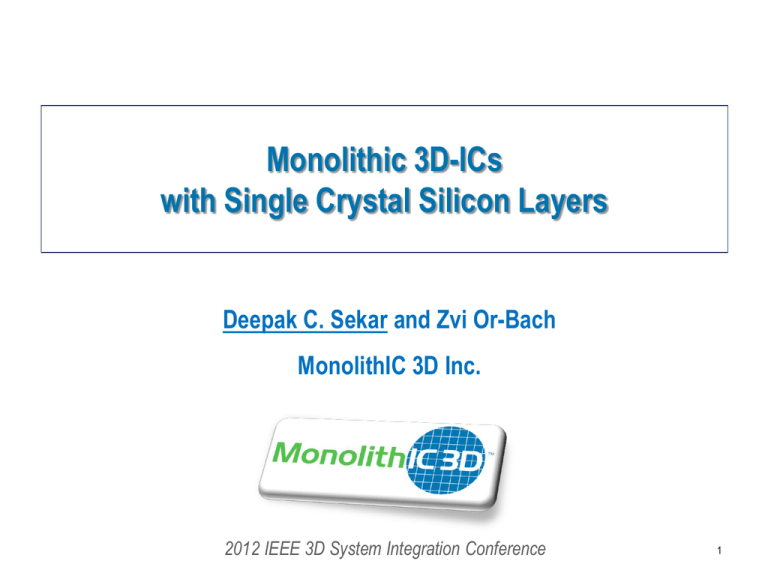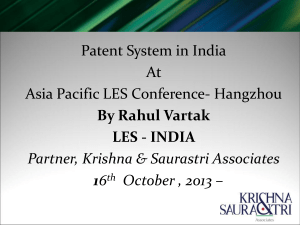Slide - MonolithIC 3D Inc.
advertisement

Monolithic 3D-ICs with Single Crystal Silicon Layers Deepak C. Sekar and Zvi Or-Bach MonolithIC 3D Inc. 3D Inc. Integration Patents Pending Conference 2012 IEEE MonolithIC 3D System 1 Flash Industry Aggressively Moving Towards Monolithic 3D Technology Samsung NAND Flash Roadmap J. Choi, et al., VLSI 2011 The advent of 3D NAND memories may be only two or three years away, speakers said at Semicon West in San Francisco. By 2013 the major memory companies developing 3D NAND, including Hynix, Samsung, and Toshiba, may be ready with pilot lines, moving to volume production a year or so later... 0.1 Design Rule (nm) 3D NAND may be pulled in to 2013-2014 By David Lammers, July 2011 1 10 100 1000 1994 2004 2014 2024 Year Multiple layers of polysilicon transistors MonolithIC 3D Inc. Patents Pending 2 This Presentation Background (and Reasons for Flash Interest in Monolithic 3D) Single-Crystal Silicon Monolithic 3D Technology for: - Memory - Logic Risks and Challenges Conclusions MonolithIC 3D Inc. Patents Pending 3 Background (and Reasons for NAND Flash Move Towards Monolithic 3D) MonolithIC 3D Inc. Patents Pending 4 Challenge 1: Lithography NAND Flash: Quad-patterning next year costly. EUV delayed, costly. Can we get benefits of scaling without relying on lithography? MonolithIC 3D Inc. Patents Pending 5 Challenge 2: Interconnect 32nm NAND flash chip 10mm Technology Node Delay of 1mm wire 90nm 5x102ps 45nm 2x103 ps 22nm 1x104 ps 12nm 6x104 ps 2.5x every generation NAND flash memory 10mm minimum size wires. Wire RC challenge Can we move to next-generation technology that improves wires? MonolithIC 3D Inc. Patents Pending 6 Challenge 2: Interconnect (contd.) Source: W. J. Dally, Keynote at Supercomputing 2010 At the 28nm node, in nVIDIA’s logic chips, Floating Point Operation = 20pJ, Integer Operation = 1pJ. But operands to/from register file = 26pJ, Caches: L1/L2/L3 = 50pJ/256pJ/1nJ, DRAM = 16nJ MonolithIC 3D Inc. Patents Pending 7 Challenge 3: Transistor Quality With scaling, Flash: Transistors get much worse, Logic: Major transistor changes Variability an issue Can we move to next-generation technology that doesn’t degrade transistors? MonolithIC 3D Inc. Patents Pending 8 How to get stacked single crystal silicon layers MonolithIC 3D Inc. Patents Pending 9 Ion-cut (a.k.a Smart-CutTM) Can give stacked defect-free single crystal Si layers atop Cu/low k Oxide Activated n Si Top layer Hydrogen implant Flip top layer and Cleave using 400oC of top layer bond to bottom layer anneal or sideways Oxide Activated n Si mechanical force. CMP CMP. Activated n Si H Activated n Si Oxide H Oxide Oxide Bottom layer Similar process used for manufacturing all SOI wafers today Cost of Ownership Analysis for Ion-Cut Could be affordable for memory if free market scenario exists SiGen and Twin Creeks Technologies using for cost-sensitive solar market MonolithIC 3D Inc. Patents Pending 11 Monolithic 3D NAND Flash Memory USP: Single-crystal silicon vs. poly Si for rest of industry MonolithIC 3D Inc. Patents Pending 12 3D NAND flash approaches are poly Si based today… Toshiba BiCS Vertical, poly Si Samsung VG-NAND Horizontal, poly Si Macronix junction-free-NAND Horizontal, poly Si Poly Si low mobility, high variation, large sub-threshold slope 2 bits/cell hard MonolithIC 3D Inc. Patents Pending 13 Our Single-Crystal Silicon Memory Cell CG n+ ONO layer 1 ONO layer 2 n+ n+ SiO2 CG Double gate single-crystal Si cell Fully-depleted device Two charge trap layers per cell MonolithIC 3D Inc. Patents Pending 14 Process Flow: Step 1 Fabricate peripheral circuits followed by oxide layer Silicon Oxide Peripheral circuits Process Flow: Step 2 Layer transfer single crystal silicon using ion-cut Silicon Oxide n+ Silicon Silicon Oxide Silicon Oxide Peripheral circuits Process Flow: Step 3 Form multiple Si layers Silicon Oxide 06 Silicon Oxide 06 Silicon Oxide 06 Silicon Oxide n+ Silicon Silicon Oxide Silicon Oxide Silicon Oxide Peripheral circuits Process Flow: Step 4 Use common litho and etch step to define multiple layers Silicon Oxide 06 Silicon Oxide 06 Silicon Oxide 06 Silicon Oxide 06 Silicon Oxide 06 Silicon Oxide 06 Silicon Oxide Peripheral circuits Symbols Shared litho step n+ Silicon Silicon oxide Process Flow: Step 5 Deposit gate dielectric, electrode, CMP, pattern and etch NAND string Silicon Oxide 06 Silicon Oxide 06 Silicon Oxide 06 Silicon Oxide 06 Silicon Oxide 06 Silicon Oxide 06 Silicon Oxide Peripheral circuits Symbols Shared litho step n+ Silicon Silicon oxide Gate electrode 3724 Gate dielectric Select gates Process Flow: Step 6 Oxide, CMP, form bit-lines, cell source regions Wiring for select gates WL Silicon oxide Silicon Oxide 06 Silicon Oxide 06 Silicon Oxide 06 Silicon Oxide 06 Silicon Oxide 06 Silicon Oxide 06 Three BitLines (BL) of n+ Si Silicon Oxide Peripheral circuits Cell source regions Gate dielectric Silicon oxide n+ Silicon Gate electrode MonolithIC 3D Flash vs. Conventional NAND vs. BiCS Estimates from 2010 VLSI Symposium short course on 3D Memory. 140 sq. mm die Density Conventional NAND 22nm node BiCS 32 layers @ 45nm node MonolithIC 3D Flash 8 layers @ 22nm node 64Gbit (3 bits/cell) 128Gbit (1 bit/cell) 256Gbit (2 bits/cell) 60:1 hard to manufacture 16:1 Aspect ratio MonolithIC 3D Flash 4x improvement in density at similar number of litho steps Manufacturable aspect ratios Benefit due to shared litho steps, single crystal silicon MonolithIC 3D Inc. Patents Pending 21 Monolithic 3D DRAM, Resistive Memories Shared litho architectures enabled by c-Si stacking MonolithIC 3D Inc. Patents Pending 22 3D Shared Litho Architectures Monolithic 3D DRAM Monolithic 3D Resistive Memories Floating body RAM Without single crystal silicon, charge leakage Resistive memories Shared litho steps, monocrystalline transistor selectors [Ref: US Patent #12/901890, MonolithIC 3D Inc.] 23 Monolithic 3D Logic USP: Shorter wires. So, gates driving wires smaller. MonolithIC 3D Inc. Patents Pending 24 28nm CMOS Technology with TSVs Symposium on VLSI Technology 2011 28nm 6um Keep-Out Zone 5um TSV occupies 6um + 5um + 5um On-chip Features Area Ratio Keep-Out Zone 5um = 16um = 28nm = (16000nm/56nm)2 ~ 100,000x Other companies offerare similar TSVs fat! large size TSVs MonolithIC 3D Inc. Patents Pending 2525 The Monolithic 3D Challenge Needs Sub-400oC Transistors for Cu/low k Compatibility Sub-400oC possible? Single Crystal Silicon Yes Shallow Trench Isolation Yes High k/Metal Gate Yes Source-Drain Dopant No activation Contacts Yes Method Ion-Cut Radical Oxidation, HDP ALD/CVD/PVD >750oC anneal Nickel Silicide Junction Activation: Key barrier MonolithIC 3D Inc. Patents Pending 26 One path to solving the dopant activation problem: Recessed Channel Transistors with Activation before Layer Transfer Layer transfer of un-patterned film. No alignment issues. Idea 1: Activate dopants before layer transfer p n+ Idea 2: Recessed channel transistors @ sub-400oC n+ p n+ Si p Si Oxide p n+ p- Si wafer p- Si wafer H Idea 3: Thin-film Si perfect alignment. TSVs minimum feature size. n+ p MonolithIC 3D Inc. Patents Pending • Minimum feature size TSVs • All steps after layer transfer to Cu/low k @ < 400oC! 27 Recessed channel transistors used in manufacturing today easier adoption GATE n+ n+ n+ p GATE GAT E n+ p V-groove recessed channel transistor: Used in the TFT industry today RCAT recessed channel transistor: • Used in DRAM production @ 90nm, 60nm, 50nm nodes • Longer channel length low leakage, at same footprint J. Kim, et al. Samsung, VLSI 2003 ITRS MonolithIC 3D Inc. Patents Pending 28 RCATs vs. Planar Transistors: Experimental data from Samsung 88nm devices From [J. Y. Kim, et al. (Samsung), VLSI Symposium, 2003] RCATs Less junction leakage RCATs Less DIBL i.e. shortchannel effects MonolithIC 3D Inc. Patents Pending 29 RCATs vs. Planar Transistors (contd.): Experimental data from Samsung 88nm devices From [J. Y. Kim, et al. (Samsung), VLSI Symposium, 2003] RCATs Similar drive current to standard MOSFETs RCATs Higher I/P capacitance MonolithIC 3D Inc. Patents Pending 30 IntSim: The CAD tool used for our simulation study [D. C. Sekar, J. D. Meindl, et al., ICCAD 2007] Open-source tool, available for use at www.monolithic3d.com IntSim v1.0: Built at Georgia Tech in Prof. James Meindl’s group IntSim v2.0: Extended IntSim v1.0 to monolithic 3D using 3D wire length distribution models in the literature MonolithIC 3D Inc. Confidential, Patents Pending 31 IntSim-based analysis @ 22nm node 22nm node 600MHz logic core 2D-IC Fine-Grain 3D 2 Device Layers 10 10 Average Wire Length 6um 3.1um Av. Gate Size 6 W/L 3 W/L Since less wire cap. to drive Optimal Die Size (active silicon area) 50mm2 24mm2 3D-IC Shorter wires smaller gates lower die area wires even shorter 3D-IC footprint = 12mm2 Logic = 0.21W Logic = 0.1W Reps. = 0.17W Reps. = 0.04W Due to shorter wires Wires = 0.87W Wires = 0.44W Due to shorter wires Clock = 0.33W Clock = 0.19W Due to less wire cap. to drive Total = 1.6W Total = 0.8W Metal Levels Power Comments Due to smaller Gate Size 3D with sub-50nm TSVs 2x lower power, 2x lower active silicon area MonolithIC 3D Inc. Patents Pending 32 Monolithic 3D is a major trend... Monolithic 3D Integration with IonCut Technology Can be applied to many market segments 3D-CMOS: Monolithic 3D Logic Technology LOGIC 3D-FPGA: Monolithic 3D Programmable Logic 3D-Repair: Yield recovery for high-density chips 3D-DRAM: Monolithic 3D DRAM MEMORY 3D-RRAM: Monolithic 3D RRAM 3D-Flash: Monolithic 3D Flash Memory 3D-Imagers: Monolithic 3D Image Sensor OPTOELECTRONICS 3D-MicroDisplay: Monolithic 3D Display 3D-LED: Monolithic 3D LED MonolithIC 3D Inc. Patents Pending 33 Summary MonolithIC 3D Inc. Patents Pending 34 To summarize.. Monolithic 3D attractive for logic, flash, DRAM and many other applications Benefits: Logic – Short wires, Smaller gates to drive wires. Less power and area Memory – Shared litho steps, short wires Risks: Competing with 2D NAND roadmap, CAD Tools, transistor optimization, etc Increasingly attractive due to lithography, interconnect trends MonolithIC 3D Inc. Patents Pending 35 Will history repeat itself? Will the monolithic idea become prevalent for 3D too? (2D) INTEGRATED CIRCUIT 3D INTEGRATED CIRCUIT Kilby version: 2D Interconnects not integrated, big sizes 3D-TSV: 3D Interconnects not integrated, big sizes Noyce version (Monolithic 2D): 2D Interconnects integrated, small sizes Monolithic 3D: 3D Interconnects integrated, small sizes MonolithIC 3D Inc. Patents Pending 36 Acknowledgements Brian Cronquist, Israel Beinglass, Ze’ev Wurman, Iulia Morariu, Andrei Dalcu, Paul Lim, Parthiv Mohan – all with MonolithIC 3D Inc. MonolithIC 3D Inc. Patents Pending 37 Thank you MonolithIC 3D Inc. Patents Pending 38 Backup slides MonolithIC 3D Inc. Patents Pending 39 Ion-cut is great, but will it be affordable? Aren’t ion-cut SOI wafers much costlier than bulk Si today? • Today: Single supplier SOITEC. Owns basic patent on ion-cut. • Our industry sources + calculations $60 ion-cut cost per $1500-$5000 wafer in a free market scenario (ion cut = implant, bond, anneal). Contents: Hydrogen implant Cleave with anneal SOITEC basic patent expires 2012!!! • Free market scenario After 2012 when SOITEC’s basic patent expires • SiGen and Twin Creeks Technologies using ion-cut for solar Industry Roadmap for 3D with TSV Technology ITRS 2010 TSV size ~ 1um, on-chip wire size ~ 20nm 50x diameter ratio, 2500x area ratio!!! Cannot move many wires to the 3rd dimension TSV: Good for stacking DRAM atop processors, but not as useful for on-chip wires MonolithIC 3D Inc. Patents Pending 41 Benefits of Monolithic 3D for Logic From J. Davis, J. Meindl, R. Reif, K. Saraswat, et al., Proceedings of the IEEE, 2001 Frequency = 450MHz, 180nm node, ASIC-like chip Our own Rent’s rule-based analysis @ the 22nm node Frequency = 600MHz, 50% Logic 50% SRAM Power Cost per die 2D-IC @22nm 2D-IC @ 15nm 3D-IC 2 Device Layers @ 22nm 1.6W 0.7W 0.8W 1 0.6 0.6 Shorter wires Smaller gate drivers Power and die size savings MonolithIC 3D Inc. Patents Pending 42 Studied by Intel and others: Power savings of 3D could make heat removal achievable Intel: Studied impact of building a Pentium 4 processor in 3D Assumed fat TSVs that reduce wire lengths only in global metal levels Global interconnects shorter in length Can meet performance target at lower clock frequency Lower power Floorplanned blocks such that low power blocks on top of high power ones MonolithIC 3D Inc. Patents Pending 43 Thermal Aware CAD Tools J. Cong, et al. UCLA Do floorplanning, place and route such that total wire length is minimized for a certain maximum temperature Does not seem to impact performance much, but keeps temperature under control MonolithIC 3D Inc. Patents Pending 44 The Heat Removal Issue: Low-Power Chips the Biggest Market for 3D MonolithIC 3D Inc. Patents Pending 45 Challenge 2: Interconnect (contd.) Wire RC trend in AMD chips Source: S. Naffziger, Keynote at the VLSI Symposium 2011 Sam Naffziger, AMD Corporate Fellow “We are at the cusp of a dramatic increase in wire RC delays. Revolutionary solutions may be required.” MonolithIC 3D Inc. Patents Pending 46








